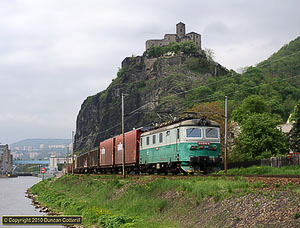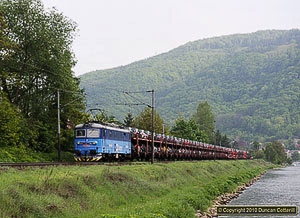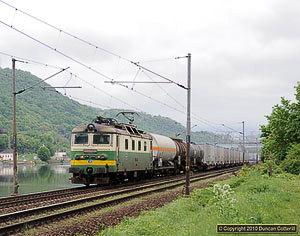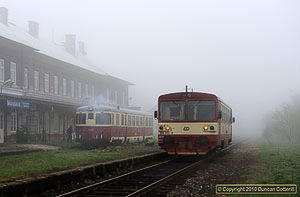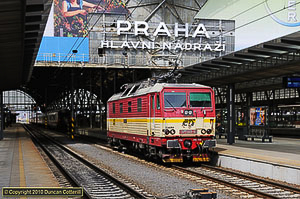Northern Freight Lines and Branches
13 - 16 May 2010
Report by Duncan Cotterill
Introduction
Following a couple of years when I’ve concentrated on the remaining diesel worked lines in the Czech Republic, it was time to try to fill some of the gaps in my electric coverage. Usti nad Labem is a busy centre for freight and passenger traffic, with a good variety of loco classes and types of traffic and some excellent photo locations nearby. I spent four days there, from 13 to 16 May 2010, but my plans were scuppered by the weather and I spent most of the time exploring. As a result, this report is more of a description of the lines ridden than of the photographic locations visited.
This report is divided into two parts: This page contains a summary of the trip. The Day by Day section contains details of each day’s activities, trains seen, travel, hotels etc.
Line 072 Usti nad Labem - Litomerice - Lysa n/L
This was my main target for the trip. Line 072 is a busy, double-track, electrified line that runs along the east bank of the River Labe, better known by its German name, the Elbe. The line runs south-east for almost 100km from Usti nad Labem, an industrial town and railway hub, to Lysa nad Labem, where it joins the route from Praha to Nymburk and Kolin.
This is one of the Czech Republic’s main freight routes, carrying traffic from eastern Germany towards the south and east of the Czech Republic and onwards to Slovakia, Hungary and Austria. There are also significant flows of coal from the mines around Most and Chomutov to power stations in the central part of the country, oil and gas tanks from the refinery at Litvinov and new cars from the Skoda factory at Mlada Boleslav. Older classes 122 and 123 still handle the majority of freights with classes 130, 163 and DB class 180 also appearing, as well as occasional class 121 electrics and class 753.7 diesels.
The passenger service consists of 2-hourly fast trains from Usti nad Labem zapad to Kolin and 2-hourly all-stations trains from Usti nad Labem zapad to Lysa nad Labem with additional all-stations trains running over parts of the route at busier times. Virtually all the passenger trains are hauled by class 163 electrics. The main exception at the Usti end of the line is a through train from Dresden to Litomerice that runs on weekends and holidays using a DB Regio class 642 unit.
There are some good positions along the banks of the Labe, a couple of km south of Usti nad Labem-Strekov, and to the south-west of Sebuzin. The road bridge just west of Litomerice mesto gives a superb view of the line passing some of the fine baroque buildings the town is famous for. I spent the latter part of Thursday afternoon and much of Saturday morning by the river south of Strekov attempting to get some shots in good light but the clouds weren’t co-operative. A couple of hours at Litomerice around Saturday lunchtime were equally unsuccessful.
Line 073 Usti nad Labem-Strekov - Decin
This line acts as a link between the Dresden - Decin main line and Usti nad Labem-Strekov for freights bound from Germany to the south and east. Types of traffic and motive power are similar to those seen on Line 072 but there are fewer trains. Passenger services are worked by class 810 railbuses.
There appeared to be some photo positions on the east side of the line between Male Brezno and Techlovice but little of interest elsewhere.
Line 090 Praha - Usti nad Labem - Decin
The line from Praha north to Decin forms part of international corridors 1 and 4 and has been upgraded progressively over recent years. It’s double track and electrified and runs up the west bank of the Vltava and Labe rivers. It carries a significant volume of freight as well as international and domestic passenger services.
EuroCity trains run from Dresden to Praha every 2 hours for much of the day. Many trains start further north, usually at Berlin or Hamburg, and continue further south to Wien, Villach, Bratislava or Budapest. Most trains are still hauled by CD class 371 locos between Dresden and Praha but ÖBB class 1216 electrics now have a diagram that takes them through to Dresden and more will surely follow. In addition to the EuroCity services, there are 2-hourly fast trains from Praha to Cheb via Usti nad Labem and 2-hourly fast trains from Praha to Decin, both hauled by class 162 electrics. Local services between Praha and Usti nad Labem are worked by class 471 EMUs. These units also work a number of Decin - Usti nad Labem - Most services at weekends but the vast majority of trains on this route are loco hauled by class 163 electrics. Fast trains from Liberec to Usti nad Labem also use the line between Decin and Usti. Most are railcars but two return trips are booked to be hauled by class 750 diesels.
Despite Line 072 being regarded as the primary freight route south from Decin and Usti, Line 090 also sees heavy traffic including container trains to the Praha area and coal and oil trains to the power stations and chemical works along the west bank of the Labe. Motive power tends to be similar to Line 072.
There aren’t many potential photo positions on line 090 in the Usti nad Labem area and the weather dissuaded me from investigating the few that showed any promise.
Line 092 Neratovice - Kralupy nad Vltavou
A nondescript single track line that does see a few diesel hauled freights but has very little photographic potential.
Line 114 Lovosice - Louny - Postolprty
A single track cross-country route operated by class 810 railbuses. The scenery is pleasant but there’s little of interest en-route.
Line 123 Zatec - Postolprty - Most
It’s normal for a railway’s infrastructure to match the traffic on offer but Line 123 doesn’t fit the stereotype. Its an electrified line, double track for much of its length, with little obvious reason to be there. Line 123 diverges from Line 130 east of Most and heads south passing the power station at Pocerady after 14km. After another 7km the line turns west at Postolprty and continues in that direction for 11km to Zatec, a market town with a little industry. The line becomes single track somewhere between Pocerady and Postolprty. The electrification continues north along Line 124 to Brezno, 14km north of Zatec and 11km south of Chomutov. At Brezno there is a connection with the mining railway serving the huge Tucimice opencast mining operation.
Most of the coal from Tusimice goes out via Kadan, on the Chomutov - Karlovy Vary line and Pocerady Power Station also appears to have a direct connection to the opencast mine south of Trebusice, so the only potentially significant freight flow would appear to be coal from Brezno to Pocerady. I didn’t see any coal trains on my Friday trip from Postolprty to Zatec and back to Most so it’s unclear how frequently these run. Passenger services are worked by class 810 railbuses.
Why the line justifies double track and electrification is still unclear. If it was necessary in the past, it certainly doesn’t appear to be now.
Line 126 Most - Louny - Rakovnik
A single track cross-country route operated by class 814/914 units. The scenery is pleasant but there’s little of interest en-route.
Line 130 Usti nad Labem - Most - Chomutov
This double-track, electrified line runs west from Usti nad Labem through one of the most industrialised areas of the Czech Republic. Many of the mines and factories have closed since the end of the communist era but a number of large power stations, opencast coal mines and other heavy industries remain.
Fast passenger services run at 2-hourly intervals from Praha to Cheb via Usti nad Labem, Most and Chomutov. These trains reverse and change engines at Usti nad Labem with a class 363 working from Usti to Cheb. Local passenger services between Usti and Most are provided by Decin - Usti - Most trains. During the week these are hauled by class 163 electrics but at weekends some trains are worked by class 471 EMUs.
Freight traffic is dominated by coal from the opencast mines around Trebusice, west of Most, as well as collieries further west. The country’s largest oil refinery at Litvinov, north of Most, is also a major source of traffic. Class 122 and 123 locos work most freights on line 130 east of Most with Unipetrol 753.7s on some of the oil trains from the Litvinov refinery.
The line is overgrown for much of its length and looks poor for photography.
Line 131 Usti nad Labem - Bilina
Most passenger trains between Usti nad Labem and Bilina, east of Most, take Line 130, a rather indirect route that serves the large town of Teplice v Cechach. Line 131 provides an alternative double track, electrified line that is both shorter and less steeply graded than the Teplice route but doesn’t serve any large population centres. Although the line is electrified from end to end, the passenger service is worked by class 810 diesel railbuses.
I didn’t spend long enough in the area to determine what proportion of through freight traffic goes via 131 instead of 130 but based on observation, some of it certainly does. The large opencast mine at Ledvice connects to the line as do several factories on the outskirts of Bilina and a power station and other industries at Trmice, just west of Usti nad Labem. Viamont have a loco depot at Trmice that contained more than a dozen locos of classes 720, 730, 740 and 753.7 when I passed on the Friday afternoon.
Photographically, the line has little to offer, being heavily overgrown for much of its length.
Line 134 Teplice v Cechach - Litvinov
Like line 131, this line looked to have the potential of being an alternative freight route, giving access to the Litvinov refinery complex and the north end of PJ Most (Most Yard). Line 134 leaves Line 130 just west of Oldrichov u Duchcova and is single track throughout and electrified as far as Louka u Litvinova, the station before Litvinov and the junction with Line 135 from Most to Moldava v Krusnych horach.
After a trip over the line, I’m convinced that it doesn’t see much, if any, freight these days. The line used to serve a number of coal mines and may once have been busy but little evidence of any rail-connected industry remains. There are few passing loops and no direct connection to the Litvinov refinery or PJ Most (see Line 135). Passenger trains are worked by class 810 railbuses and from the condition of the railheads, it looked like nothing heavier had worked over the line for a while. I hadn’t spotted it at the time but the Czech atlas actually notes that the electrification is out of use.
The line is virtually devoid of photographic potential.
Line 135 Most - Moldava v Krusnych horach
This line leaves Line 130 a couple of km west of Most and heads north, soon reaching the south end of Most Yard. The line skirts the east edge of the yard and then runs up the east side of the Litvinov refinery and around the eastern fringes of the town of Litvinov to Louka u Litvinova where it meets Line 134 (see above). The line is electrified all the way from Most to Louka and single track from the south end of Most Yard to Louka.
As with Line 134, the passenger service is worked by class 810 railbuses and there appears to be little, if any, freight traffic. Trains to the Litvinov refinery run directly from Most Yard on parallel industrial lines. There is a Unipetrol loco depot just inside the boundary wall of the Litvinov refinery, close to Most-Minerva station. On Saturday afternoon it contained around a dozen locos, mainly 753.7s.
Soon after leaving electrified territory at Louka v Litvinova, the line enters beautiful broadleaf woodland and climbs through the trees for 16km to Dubi where trains have to reverse to climb the last 9km to Moldava. There aren’t many clear spots but occasionally the forest thins enough to allow glimpses of the grimy industrial towns way below. The station at Moldava is 780m above sea level, on top of a mountain in the middle of nowhere and high enough to be in the clouds when I visited. It’s also right on the German border, literally. The border signs run along the north side of the station yard and the line used to cross into Germany 300m further on.
Although it’s an interesting line to ride, there isn’t much photographic potential.
Comment
Although I didn’t get the pictures I was after, the trip wasn’t a total waste of time. It was interesting to ride some of the lines I’d been curious about for years, even though there was little to make me want to go back to any of them. The maze of lines that once served the heavy industries of the area now seems to host nothing more interesting than class 810 railbuses.
The mining industry appears to have consolidated its operations into a few massive, mechanised opencast mines with all the smaller mines having closed. The opencasts still produce a huge volume of coal, the vast majority of it going out by rail from the loading points at Ledvice, east of Bilina, Trebusice, west of Most, and Tusimice, west of Chomutov. Some of these mining operations have their own railway systems. Tusimice’s 3kV electrified system, with its class 114, 130 and 184 locos, is fairly well known but there are also monster 1500V DC 3-section Bo+Bo+Bo locomotives in use around the mines at Trebusice, Sokolov and possibly elsewhere. I’d hoped to find some of these locos at other locations and preferably at places where they could be photographed but didn’t see any.
CD’s new liveries are starting to appear on a significant number of locos, coaches and units. While CDCargo’s two tone blue looks great on the older class 122 and 123 locos, the passenger livery, which has a lot more grey in it, makes the locos of classes 163, 363 and 371 look rather boxy. In reality, they are rather boxy but the earlier liveries suited them well. One of the great attractions of Czech railways has long been the variety of attractive and imaginative liveries applied, particularly to diesel locomotives, and the future currently looks a bit drab and boringly uniform. On a more hopeful note, variations are starting to appear already. A Plzen 363 was seen at Praha carrying a modified livery with the grey replaced by cream.
This report is divided into two parts: This page contains a summary of the trip. The Day by Day section contains details of each day’s activities, trains seen, travel, hotels etc.
